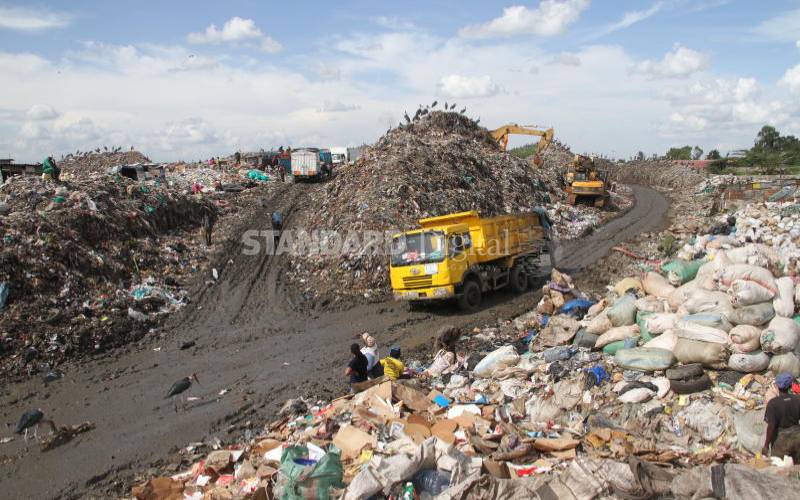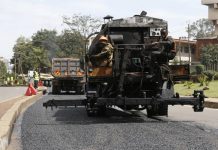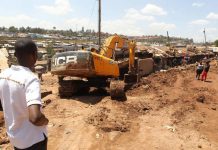AfricaPress-Kenya: The miniature mountains of garbage in many parts of the capital tell a story of a city choking in the trash and a legion of unmet promises by the authorities.
From the mounds of garbage in the city backstreets, estates, and sewerage lines, to the Marabou storks scavenging in the plastic that dominates Nairobi’s Dandora dumpsite, it is apparent that the ‘city under the sun’ is quite far behind in its recyclable waste-to-energy journey.
For years, Nairobi residents have had to put up with a string of broken vows from one administration to another, on how they plan on addressing the garbage menace that has plagued residents since time immemorial.
The latest is a pledge by the Nairobi Metropolitan Services (NMS), in collaboration with the Kenya Electricity Generating Company (KenGen), to put up a Sh20 billion waste to the energy recycling plant at the Dandora dumpsite.
The waste was then to be converted to 60MW of clean, renewable energy per day to be supplied to the national grid. The project is, however, yet to be implemented.
It is not the first time the renewable-waste-to-energy plant has been offered as the silver bullet to cure the garbage mess. The promise dates as far back as 2015, during former Nairobi Governor Evans Kidero’s tenure, when the idea was mooted.
Kidero’s government would in 2016 proceed to ink a Sh28 billion deal with a German-based company, EMC Solutions, which was to set up the recycling plant. The company however lost the deal following an “oversight” on the part of the city’s county government officials.
The then Environment Executive, Peter Kimori, owned up, saying it was a mistake to engage the German firm to build the plant at the Dandora dumpsite without a feasibility study, as required in law, and proceeded to pull out from the deal.
Then came the Governor Mike Sonko-led administration in 2017, whose ascension to power was premised on, among other factors, a solution to the garbage problem. Within a year in office, Sonko, in 2018, revived plans for the Dandora recycling plant, saying up to 60 local and international firms had expressed interest in setting up the plant on the 43-acre dump site.
City Hall would go silent on the matter, until February 2020, when it announced that it had rejected all the bids to set up the plant.
It stated that out of the 60 companies that had applied, only 26 were shortlisted, but ultimately they, too, had been found not to have the capacity to put up the power plant. It proceeded to reopen the tendering process.
This paved way for the project to be undertaken by the Nairobi Metropolitan Services shortly after the county ceded its four functions, namely Planning, Housing, Transport, Health and Public works as well as auxiliary services such as Environment.
Mohammed Badi’s institution then resolved to bring KenGen on board and consequently announced that the project would begin in December 2020. But due to unforeseen circumstances, Maj-Gen Badi would later announce that the tendering process for the power plant would commence in January 2021.
“Initially, the project was supposed to start last month (December), but it encountered a delay in the tendering process following the completion of feasibility studies by KenGen,” said Badi. “The process is out and we have set an agreement between us and the ministry. They will set up the factory and NMS will supply them with garbage.”
Under the deal, NMS is expected to make available the land within or around Dandora dumpsite, while KenGen will finance, develop and operate the power plant. Presently, KenGen provides power from hydro, thermal, and geothermal sources countrywide.
Another yet to be realised promise is the relocation of the county’s official dumpsite from Dandora to Ruai.
What went wrong?
The Dandora dumpsite is more than three times full, holding more than 1.8 million tonnes of solid waste against a capacity of 500,000 tonnes, with more than 3,500 tonnes of waste deposited at the site daily.
This pledge was mooted by Sonko’s administration in 2018 following the widespread rot in the city. It was also premised on the reality that Dandora residents constantly grappled with the risks of typhoid and cholera, illnesses that arose from poor sanitation or contaminated water sources.
In July 2018 however, City Hall announced that the plan had been halted due to unavailability of land.
Initially, City Hall had planned a 500-acre dump site in Ruai. But the Kenya Civil Aviation Authority (KCAA) opposed the move, saying the new site lay beneath a flight path.
The agency argued that birds attracted by the waste would interfere with flight operations.
City Hall was then sent back to the drawing board and resorted to compacting waste at Dandora dumpsite to create space for more garbage, pending the setting up of a recycling plant.
Fast forward to 2020, and the same plan was revived by the NMS, which vowed to set up a landfill in Ruai to help decongest the Dandora dumpsite. It further announced plans to introduce material recovery facilities to reduce open dumping of waste. The plants would receive, separate, and produce recyclable materials for sale.
Nairobi County Environment and Water Executive Larry Wambua now blames political interference on the setting up of the plant as the major hindrance to the county sorting out the garbage menace.
He says since the inception of the idea, politicians allied to both sides of the political divide have been seeking a stake in the multi-billion shilling power plant project.
“A lot of the delays have been because of vested interests by politicians. They, in one way or another, wanted to be involved,” said Mr Wambua, reiterating that Badi had no vested interests and just wanted to do what is best for the city.






